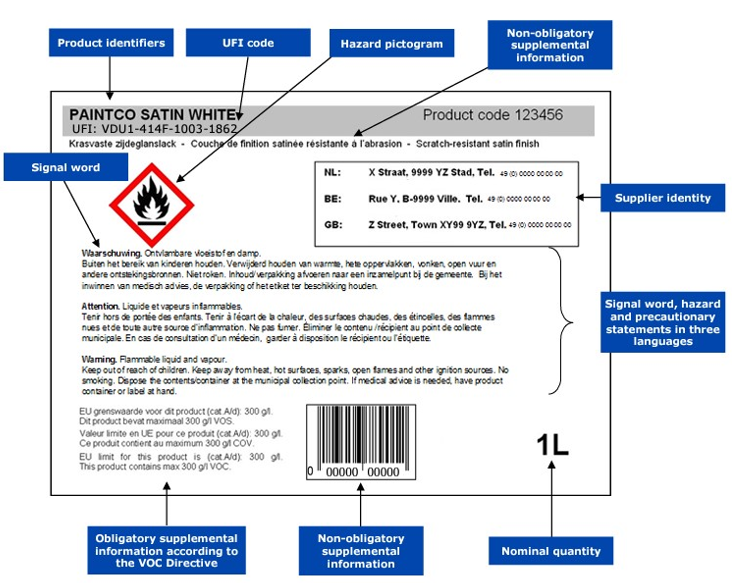The following content has been prepared with reference to the integrated version of the CLP Regulation (REGULATION (EC) No 1272/2008 OF THE EUROPEAN PARLIAMENT AND OF THE COUNTIL of 16 December 2008 on classification, labeling and packaging of quantities and mixtures, amending and repeating Directives 67/548/EEC and 1999/45/EC, and amending Regulation (EC) No 1907/2006), with the latest revision date from November 12, 2021.
The label generally refers to the printing on the middle box, small box, candy bag, Electronic cigarette, cigarette cartridge, cigarette oil bottle, etc. of Electronic cigarette.

General requirements for labeling: The mixture label should include the following content (consistent with the first chapter of SDS)
Product supplier name, address, phone number (Supplier Identity)
Nominal Quantity
Product identification: Sufficient information to identify the product, consistent with the content of SDS, as specified in Article 18 (Product Identifiers)
Product name
Specific hazardous substances (consistent with Chapter 2 of SDS):
Write a maximum of 4 substances, unless they cannot clearly describe the hazards of the product
Substances/components that contribute to the following CLP classifications need to be reflected: acute toxicity, skin corrosion, eye injury, CMR, respiratory allergies, skin allergies, STOT, inhalation hazards, etc
When applicable, the Hazard Pictogram should be consistent with the content of Chapter 2 of SDS (Hazard Pictogram)
The danger pictogram should be square
The danger pictogram should have a black symbol on a white background and a red border. The border should be wide enough to be clearly visible
The hazard pictogram should occupy at least 1/15 of the area of the CLP label; Each hazard pictogram must have a minimum of 1cm2
For Electronic cigarette/cigarette oil (no more than 3L of liquid), the area of the entire CLP label, if feasible, shall not be less than 52mm * 74mm; Danger pictogram not less than 10mm * 10mm, if feasible, not less than 16mm * 16mm
Signal word, consistent with the content of Chapter 2 of SDS (Signal Word)
Danger; Warning.
If the signal word 'Danger' is used on the label, the signal word 'Warning' must not appear on the label.
When applicable, the hazard statements should be consistent with the content of Chapter 2 of the SDS (Hazard Statements)
When applicable, the protective instructions should be consistent with the content of Chapter 2 of SDS (Precautionary Statements)
When applicable, provide supplementary explanations that are consistent with the content of Chapter 2 of SDS (Supplementary Information); UFI must be reflected.
Note: Although CLP considers UFI as supplementary information, it is included in Section 1.1 (Product Identifiers) of SDS
The above content should be expressed in the official language of the local country
The labels of different packaging should reflect the following information:
3.1 Medium box, small box, candy bag (candy bag as outer packaging)
Product identification
Contact information (name, phone number) of the manufacturer or importer
Product quantity
Volume of tobacco oil
Applicable hazard pictograms
Signal word
Hazard statement (if applicable)
Protective instructions (if applicable)
Supplementary instructions (if applicable) must be reflected in UFI.
3.2 Electronic cigarette, cigarette cartridge and cigarette oil bottle
When the packaging is too small or has shape issues that cannot display all the applicable information required by CLP, the information can be placed on folding labels, tie up labels, or outer packaging (CLP Article 29 (2)). When the outer package is used, the inner package (direct container, such as Electronic cigarette, cigarette bomb, cigarette oil bottle) shall at least display the following information (CLP Annex I section 1.5.1):
Product identification
Contact information (name, phone number) of the manufacturer or importer
Applicable hazard pictograms
UFI (recommended, not mandatory)
3.3 Candy bags
According to CLP article 33 (1), intermediate packaging also needs to comply with labeling requirements.
If candy bags are used as intermediate packaging, based on the understanding of CLP Annex I section 1.5.1, they must at least meet the requirements of 3.2.
Note: If the outer packaging allows clear visibility of the inner or intermediate packaging labels (with comprehensive information), the outer packaging may not be labeled (CLP article 33 (2)).
If you have any questions, please contact us. We are dedicated to providing you with high-quality testing and certification services.
Contact number: 0755-28506411
Email address: service@element-testing.com
Website: http://www.element-testing.com
Shenzhen Element Testing Co., Ltd. (referred to as Element) focuses on providing testing and compliance services for electronic atomizer enterprises.
The Element Laboratory is equipped with dozens of advanced detection instruments and equipment, such as imported vaping machines, liquid chromatography triple tandem four pole liquid mass spectrometry (LC-MSMS), Inductively coupled plasma mass spectrometry (ICP-MS), gas chromatography mass spectrometry (GC-MS), Inductively coupled plasma emission spectrometry (ICP-OES), high-performance liquid chromatography (HPLC-DAD), gas chromatography (GC-FID/ECD/TCD), ion chromatography (IC) X-ray fluorescence spectroscopy analyzer (XRF), etc.
The staff of the Element laboratory all have a bachelor's degree or above and have worked in the field of testing and compliance services for many years. Among them, the engineers of the electronic atomizer project are the first batch of senior experts in China engaged in electronic atomizer testing and compliance services.
笔记

